The 2000 presidential election was the first in which the Internet was used as a significant -- even primary -- tool for disseminating political and campaign information. And as the 2004 election fast approaches, presidential candidate Howard Dean, who has mobilized a legion of political supporters online, has proven the effectiveness of the Internet as a campaign tool. Gallup data suggest that this medium, novel and innovative just eight years ago, has become an essential component of the American political realm.
A January 2000 Gallup Poll showed that just under a third of Americans (31%) "frequently" or "occasionally" used the Internet to get news or information about politics or the presidential candidates, with just 16% falling into the top category (frequently). More than half (54%) said they never used the Internet for these purposes.
Those percentages have increased significantly in the past four years. Data from a January 2004 survey* show that today, nearly half (49%) of Americans use the Internet at least occasionally to get political or candidate information, with 28% saying they do so frequently. Slightly more than a third (35%) say they never log on to get political or candidate information. Because Gallup polling typically finds that about a third of Americans don't use the Internet at all, these data suggest that most Internet users are getting at least some political information from the Web.
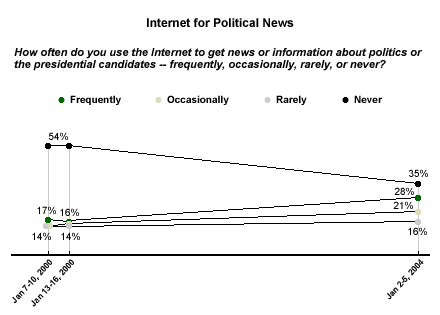
The rise in Internet use for campaign information has occurred among most demographic groups. Younger Americans are one notable exception -- they were already using the Internet at fairly high rates early in the 2000 campaign.
Several major factors are responsible for the public's increased use of the Internet this election year: the market penetration of computers and Internet services; news sites and portals covering political events in greater breadth and depth; and the fact that the presidential candidates are doing far more of their fundraising, volunteer-recruiting, and campaigning online than they ever have before.
Who's Online?
A demographic breakdown of this question turns up the usual suspects when it comes to frequent Internet use. Age, gender, income, and education level are the best predictors of whether an individual uses the Internet for political and candidate information.
Men are more likely than women to log on frequently for those purposes (34% to 22%). The percentages of men and women using the Internet frequently for political information have both increased significantly since 2000, although the percentage of men has increased slightly more (10 percentage points for men, 6 for women).
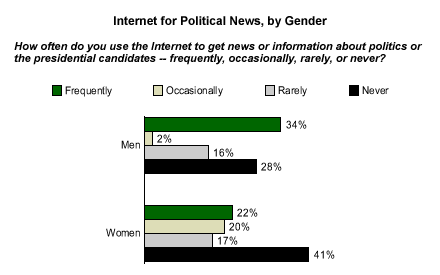
With regard to age, the percentage of Americans saying they frequently get candidate information online drops dramatically among those aged 65 and older. Only 11% of Americans over 65 use the Internet frequently for political information, compared with 28% of 50- to 64-year-olds, 34% of 30- to 49-year-olds, and 32% of 18- to 29-year-olds. Frequent use of the Internet for political information has not changed among the youngest age group (18- to 29-year-olds) when compared with the 2000 data, however there have been increases of 7 to 10 percentage points among the other age categories.
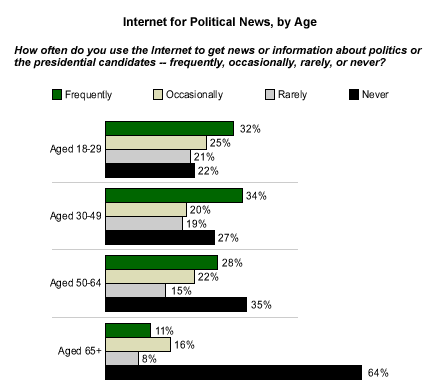
Nearly half of Americans with a postgraduate education (48%) say they frequently use the Internet to get political information; this percentage decreases steadily by education level. Sixteen percent of those with a high school education or less frequently access political information online. Frequent use of the Internet for political information has also increased most significantly (18 percentage points) between 2000 and 2004 among postgraduates. The smallest increase (five percentage points) occurred among those with a high school education or less.
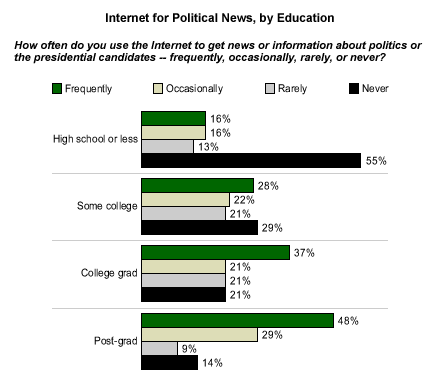
The percentage of people saying they frequently use the Internet for political news and information also spikes significantly among those with annual household incomes above $75,000 (45% do). Those with lower income levels are less likely to log on for political information, as no more than 30% of those in income groups below $75,000 say they use the Internet often to find campaign information. Interestingly, the percentage using the Internet frequently for this purpose has increased very little since the last presidential election among the middle-income categories, but has increased more significantly among those in the lowest (less than $30,000, a 15-point increase) and highest ($75,000 or more, a 16-point increase) income levels.
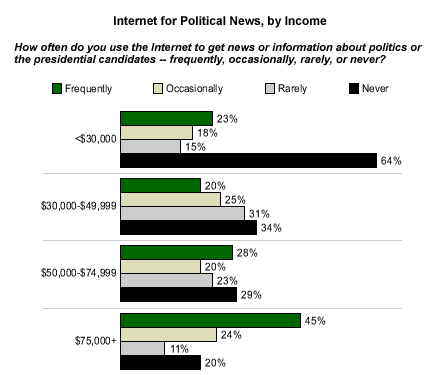
Bottom Line
Throughout the early stages of this campaign, Dean has been touted for successfully using the Internet to drum up support. Dean has raised millions of dollars over the Internet (his campaign raised a total of $40 million in 2003), and organized political supporters from across the country using Web sites. If Gallup's findings are any indication, Dean's campaign will serve as a model for presidential candidates in 2004, 2008, and beyond.
*Results are based on telephone interviews with 1,029 national adults, aged 18 and older, conducted Jan. 2-5, 2004. For results based on the total sample of national adults, one can say with 95% confidence that the maximum margin of sampling error is ±3 percentage points.
